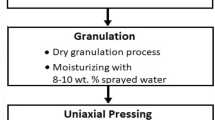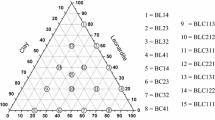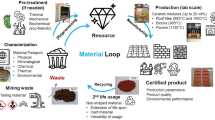Abstract
The present study investigated the potential of utilizing the cutting dust waste generated in the sizing process of volcanic tuff stones as an alternative to the traditional raw materials of industrial floor tile formulations. Within the scope of the research, Döger region (Afyonkarahisar, Turkey) tuff waste was used in varying amounts (up to 7 wt. %) to substitute feldspar (albite) in the industrial formulation partially. The ceramic tiles, which were shaped at 20 MPa pressure by uniaxial pressing from the mixtures obtained by partial substitution of albite by tuff waste, were fired in an industrial furnace at 1180 °C for 50 min. When the pre- and post-firing properties of the tuff waste-incorporated tiles were compared, one could find that 5 wt. % tuff waste incorporation to the industrial formulation provided the highest green (9.83 MPa) and fired (26.77 MPa) strength values, as well as the lowest water absorption (5.77%) value. The results indicated that 5 wt. % substitution of albite with tuff-stone cutting waste could improve the densification and fired strength of ceramic tiles. Furthermore, although it has the potential to be converted into more valuable materials, the use of tuff wastes, which are still disposed of in landfills, in ceramic tile production, will contribute to environmentally friendly solutions and protect the rare natural feldspar deposits.





Similar content being viewed by others
References
Kara A, Ozer F, Kayaci K, Ozer P (2006) Development of a multipurpose tile body: phase and microstructural development. J Eur Ceram Soc 26:3769–3782
Mukhopadhyay TK, Ghosh S, Ghosh J, Ghatak S, Maiti HS (2010) Effect of fly ash on the physico-chemical and mechanical properties of a porcelain composition. Ceram Int 36:1055–1062
Luo Y, Zheng S, Ma S, Liu C, Wang X (2017) Ceramic tiles derived from coal fly ash: preparation and mechanical characterization. Ceram Int 43(15):11953–11966
Dana K, Das S, Das SK (2004) Effect of substitution of fly ash for quartz in triaxial kaolin–quartz–feldspar system. J Eur Ceram Soc 24:3169–3175
Luo Y, Wu Y, Ma S, Zheng S, Chu PK (2019) An eco-friendly and cleaner process for preparing architectural ceramics from coal fly ash: pre-activation of coal fly ash by a mechanochemical method. J Clean Prod 214:419–428
Dondi M, Raimondo M, Zanelli C (2014) Clays and bodies for ceramic tiles: reappraisal and technological classification. Appl Clay Sci 96:91–109
Çakıcı RI (2014) Investigation of alternative raw materials used in ceramic production and cost reduction studies, M.Sc. Thesis, Istanbul University, Graduate School of Science and Engineering, Department of Mining Engineering
Baraldi L (2017) World production and consumption of ceramic tiles. Stat Tile Int 3:42–48
Öztürk Ç, Akpınar S, Tarhan M (2021) Investigation of the usability of sille stone powders as additive in floor tiles. J Aust Ceram Soc 57(2):567–577
El-Maghraby HF, El-Omla M, Bondioli F, Naga SM (2011) Granite as flux in stoneware tile manufacturing. J Eur Ceram Soc 31:2057–2063
Pazniak A, Barantseva S, Kuzmenkova O, Kuznetsov D (2018) Effect of granitic rock wastes and basalt on microstructure and properties of porcelain stoneware. Mater Lett 225:122–125
Junkes JA, Prates PB, Hotza D, Segadães AM (2012) Combining mineral and clay-based wastes to produce porcelain-like ceramics: an exploratory study. Appl Clay Sci 69:50–57
Dondi M, Marsigli M, Fabbri B (1997) Recycling of industrial and urban wastes in brick production-a review. Tile Brick Int 13:218–225
Siegesmund S, Török Á (2011) “Building Stones.” Stone in Architecture, 4th edn. Springer, Berlin, Germany, pp 11–95
Celik MY, Sert M, Arsoy Z (2019) Investigation of the effect of SO2 on the deterioration of Döğer (İhsaniye-Afyonkarahisar) tuff used as building stone, 1st International Symposium on Innovations in Civil Engineering and Technology, Afyonkarahisar
Toprak MU, Arslanbaba MA (2016) Possibility of using kütahya volcanic tuff as building stone: microstructural evaluation and strength enhancement through heat treatment. Constr Build Mater 110(1):128–134
Marino O, Palumbo M, ve Mascolo, G, (1995) Destruction of asbestos fibres by sintering asbestos-volcanic tuff mixtures. Environ Technol 16:89–94
Ergul S, Ferrante F, Pisciella P, Karamanov A, Pelino M (2009) Characterization of basaltic tuffs and their applications for the production of ceramic and glass-ceramic materials. Ceram Int 35(7):2789–2795
Celik MY, Sert M, Arsoy Z (2019) Yüzey koruyucu reçinenin Döğer tüfü ve İscehisar andezitinin kılcal su emme potansiyeli üzerine etkisinin incelenmesi. Uludağ Univ J Fac Eng 24(3):319–338 ((in Turkish))
Darweesh HHM (2001) Building materials from siliceous clay and low grade dolomite rocks. Ceram Int 27(1):45–50
Nandi VS, Raupp-Pereira F, Montedo ORK, Oliveira APN (2015) The use of ceramic sludge and recycled glass to obtain engobes for manufacturing ceramic tiles. J Clean Prod 86(1):461–470
Johnson LA, McCauley RA (2005) The thermal behavior of albite as observed by DTA. Thermochim Acta 437(1):134–139
Akpinar S, Evcin A, Ozdemir Y (2017) Effect of calcined colemanite additions on properties of hard porcelain body. Ceram Int 43(11):8364–8371
Ediz N, Yurdakul H, Issi A (2004) Use of tincal waste as a replacement for calcite in wall tile production. Key Eng Mater 264–268:2457–2460
Gil C, Peiró MC, Gómez JJ, Chiva L, Cerisuelo E, Carda JB (2006) Estudio de la porosidad en soportes del gres porcelánico. Ceram Inf 336:53–56
Gualtieri ML, Romagnoli M, Gualtieri AF (2011) Influence of body composition on the technological properties and mineralogy of stoneware: a DOE and mineralogical–microstructural study. J Eur Ceram Soc 31(5):673–685
Suvaci E, Tamsu N (2010) The role of viscosity on microstructure development and stain resistance in porcelain stoneware tiles. J Eur Ceram Soc 30(15):3071–3077
Dikmen S, Mucur T, Arsoy Z, Ersoy B (2020) The relationship between the flow properties of clay slurry samples and the properties of ceramic green/sintered products. Eur J Sci Technol 20:233–247
Das SK, Dana K (2003) Differences in densification behaviour of K- and Na-feldspar containing porcelain bodies. Thermochim Acta 406:199–206
Leonelli C, Bondioli F, Veronesi P, Romagnoli M, Manfredini T, Pellacani GC, Cannillo V (2001) Enhancing the mechanical properties of porcelain stoneware tiles: as a microstructural approach. J Eur Ceram Soc 21(6):785–793
Gil C, Peiró MC, Gómez JJ, Chiva L, Cerisuelo E, Carda JB (2006) Study of porosity in porcelain tile bodies, castellon (Spain). Qualicer 43–48
Correia SL, Hotza D, Segadaes AM (2008) Predicting porosity content in triaxial porcelain bodies as a function of raw materials contents. J Mater Sci 43:696–701
Stathis G, Ekonomakou A, Stournaras CJ, Ftikos C (2004) Effect of firing conditions, filler grain size and quartz content on bending strength and physical properties of sanitaryware porcelain. J Eur Ceram Soc 24(8):2357–2366
Dana K, Das SK (2002) Some studies on ceramic body compositions for wall and floor tiles. Trans Indian Ceram Soc 61(2):83–86
Becker CR, Misture ST, Carty WM (2000) The role of flux choice in triaxial whiteware bodies. Ceram Eng Sci Proc 21:15–29
Kurama S, Kara A, Kurama A (2006) The effect of boron waste in phase and microstructural development of a terracotta body during firing. J Eur Ceram Soc 26:755–760
Acknowledgements
This study was supported by Afyon Kocatepe University Scientific Research Projects under project No: 21.FEN.BİL.36. Our thanks go to the Yüksel Ceramic R&D Center for their technical support of the experimental studies.
Funding
Afyon Kocatepe Üniversitesi, 21.FEN.BİL.36.
Author information
Authors and Affiliations
Corresponding author
Ethics declarations
Conflict of interest
This essay is the outcome of a project funded by Afyon Kocatepe University Scientific Research Projects, 2021, Project Title: The Use of Döğer (Afyon) Tuff as a Raw Material in Ceramic Production. This study was funded by Afyon Kocatepe University Scientific Research Projects (21.FEN.BİL.36). None of the university researchers has been paid and the funds have been used only for research purposes (material characterizations). The author declares she has no financial interests. The author has no relevant financial or nonfinancial interests to disclose. The author has no competing interests to declare that are relevant to the content of this article. The author certifies that she has no affiliations with or involvement in any organization or entity with any financial interest or non-financial interest in the subject matter or materials discussed in this manuscript. The author has no financial or proprietary interests in any material discussed in this article.
Additional information
Publisher's Note
Springer Nature remains neutral with regard to jurisdictional claims in published maps and institutional affiliations.
Rights and permissions
Springer Nature or its licensor (e.g. a society or other partner) holds exclusive rights to this article under a publishing agreement with the author(s) or other rightsholder(s); author self-archiving of the accepted manuscript version of this article is solely governed by the terms of such publishing agreement and applicable law.
About this article
Cite this article
Akpınar, S., Anlı, S.T. Using volcanic tuff wastes instead of feldspar in ceramic tile production. J Mater Cycles Waste Manag 25, 2159–2170 (2023). https://doi.org/10.1007/s10163-023-01669-w
Received:
Accepted:
Published:
Issue Date:
DOI: https://doi.org/10.1007/s10163-023-01669-w




